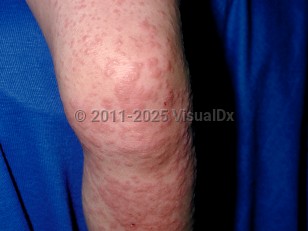Gianotti-Crosti syndrome in Child
Alerts and Notices
Important News & Links
Synopsis

Gianotti-Crosti syndrome (GCS), also known as papular acrodermatitis of childhood, is an acute onset, self-limiting dermatosis that occurs most commonly in the spring and summer.
It is characterized by papular or papulovesicular lesions mainly affecting the extensor surfaces of the extremities, buttocks, and face. Mucous membranes are typically spared; pruritus is variable. Lesions erupt over the course of 2-3 days, with new lesions continuing to appear within the first 2-3 weeks. GCS can last anywhere from 10 days to 6 months.
The syndrome is usually seen in preschool children aged 1-6 years but can be seen in children aged up to 13 years with rare case reports in adults.
While the exact pathophysiology is not known, it has been accepted that GCS results from a delayed hypersensitivity reaction to various pathogens and sometimes vaccines. Hepatitis B and Epstein-Barr virus are the 2 most common pathogens associated with the syndrome, but cases have also been reported following infection with hepatitis A and hepatitis C viruses, cytomegalovirus (CMV), enteroviruses, COVID-19, rotavirus, respiratory syncytial virus, parvovirus B19, vaccinia virus, rubella virus, HIV, and parainfluenza virus. COVID-19 vaccination has also been recognized as an inciting factor. Bacterial infections Bartonella henselae, Borrelia burgdorferi, β‐hemolytic streptococcus, and Mycoplasma pneumoniae have also been linked to GCS. The syndrome has also been observed following immunizations against poliovirus, diphtheria, pertussis, Japanese encephalitis, influenza, and hepatitis B virus and measles (together). The clinical features of the syndrome are identical, independent of the triggering agent.
A 2016 study found that children with atopic dermatitis or other manifestations of atopy were at greater risk for GCS. In adults, hormones may play a role in pathophysiology, given a female predilection in this age group.
It is characterized by papular or papulovesicular lesions mainly affecting the extensor surfaces of the extremities, buttocks, and face. Mucous membranes are typically spared; pruritus is variable. Lesions erupt over the course of 2-3 days, with new lesions continuing to appear within the first 2-3 weeks. GCS can last anywhere from 10 days to 6 months.
The syndrome is usually seen in preschool children aged 1-6 years but can be seen in children aged up to 13 years with rare case reports in adults.
While the exact pathophysiology is not known, it has been accepted that GCS results from a delayed hypersensitivity reaction to various pathogens and sometimes vaccines. Hepatitis B and Epstein-Barr virus are the 2 most common pathogens associated with the syndrome, but cases have also been reported following infection with hepatitis A and hepatitis C viruses, cytomegalovirus (CMV), enteroviruses, COVID-19, rotavirus, respiratory syncytial virus, parvovirus B19, vaccinia virus, rubella virus, HIV, and parainfluenza virus. COVID-19 vaccination has also been recognized as an inciting factor. Bacterial infections Bartonella henselae, Borrelia burgdorferi, β‐hemolytic streptococcus, and Mycoplasma pneumoniae have also been linked to GCS. The syndrome has also been observed following immunizations against poliovirus, diphtheria, pertussis, Japanese encephalitis, influenza, and hepatitis B virus and measles (together). The clinical features of the syndrome are identical, independent of the triggering agent.
A 2016 study found that children with atopic dermatitis or other manifestations of atopy were at greater risk for GCS. In adults, hormones may play a role in pathophysiology, given a female predilection in this age group.
Codes
ICD10CM:
L44.4 – Infantile papular acrodermatitis [Gianotti-Crosti]
SNOMEDCT:
82721003 – Gianotti-Crosti syndrome
L44.4 – Infantile papular acrodermatitis [Gianotti-Crosti]
SNOMEDCT:
82721003 – Gianotti-Crosti syndrome
Look For
Subscription Required
Diagnostic Pearls
Subscription Required
Differential Diagnosis & Pitfalls

To perform a comparison, select diagnoses from the classic differential
Subscription Required
Best Tests
Subscription Required
Management Pearls
Subscription Required
Therapy
Subscription Required
References
Subscription Required
Last Reviewed:09/10/2024
Last Updated:09/18/2024
Last Updated:09/18/2024
Gianotti-Crosti syndrome in Child

